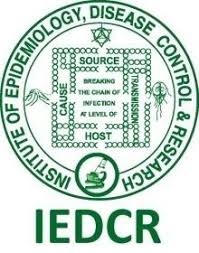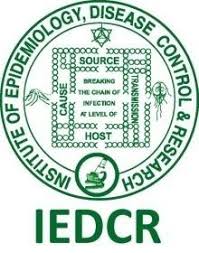About Us
IEDCR stands for Institute of Epidemiology, Disease Control and Research. The present Institute of Epidemiology, Disease Control and Research (IEDCR) was established in 1976 through a bill approved in the Parliament which called for the establishment of an institute for epidemiological and communicable disease research as well as functioning of disease control programs mainly in the form of parasitic and entomological containment of vector borne diseases through application of epidemiological...
IEDCR stands for Institute of Epidemiology, Disease Control and Research. The present Institute of Epidemiology, Disease Control and Research (IEDCR) was established in 1976 through a bill approved in the Parliament which called for the establishment of an institute for epidemiological and communicable disease research as well as functioning of disease control programs mainly in the form of parasitic and entomological containment of vector borne diseases through application of epidemiological principles. At that time, Malaria Eradication Programme (MEP) was in its death throes and a much weaker Malaria control Programme (MCP) was established along the lines of the lessons learnt from the vicissitudes of an ambitious global programme that swept the world throughout much of the sixties and seventies.That should brings us to the fore the story of the institute that carried most of the responsibilities throughout the consolidation phase of the MEP. The institute, previously known as the Malaria Institute of East Pakistan (MIEP), was relocated to its present site in the early sixties from a government building in Old Dhaka.The two storied yellow building, where the present institute is situated, was actually the storehouse for thousand of tons of DDT and other chemicals and pesticides used for the MEP. Its other rooms were used for training of malaria officers from different parts of the country. The outhouse consisted of the animal house and a hatchery for breeding of mosquitoes. The administrative units and the officers of the departmental heads along with its general sections and laboratories were situated in the six storied building that now houses the Directorate General of Health Services (DGHS) adjacent to the storehouse.The Central Malaria Institute of East Pakistan itself was bisected from the Central Malaria Institute of India (CMII) in 1947 and received a few generous gifts through the division of assets between India and Pakistan, some of which still adorn the Director’s Chamber. The mahogany officer table and some regal chairs are the reminders of our colonial past. The CMII and then CMIP, leapfrogging from New Delhi to Karachi and finally to Dhaka in 1952, started functioning as MIP in 1954 in a government bungalow in Madan Mohan Basak Lane (now Tipu Sultan Road). The MEP grew in force and resources; not to be outdone by the anticipated growth spurt of a fledgling hinterland town of Dhaka into a provincial capital with its attendant trimmings. The functions of the institute were to advise the Government and local bodies on all issued related to malaria, to carry out epidemiological investigation, undertake systemic research into basic factors including malaria transmission, prevalence, vector bionomics and to teach and train officers and auxiliary personnel of MEP.Since 1961, the institute was functioning as WHO Malaria Eradication Training Centre (METC). Its contribution in the field of malaria and training of personnel made it possible to implement countrywide MEP. Till 1971, courses conducted were – Malaria Eradication Officers’ Course. Special Epidemiological Course. Junior Malaria Eradication Officers’ Course, Microscopists’ Course etc.During the late years of 60s MEP was successfully carried out and at the same time WHO showed keen interest in assisting the development of an Institute of Epidemiology, Disease Control and Research, which was incorporated in the then Pakistan’s 4th Five Year Plan (1970-75). The objective of the Institute was to develop epidemiological services network, basic and applied field research on parasitic, viral, bacterial diseases and their vectors. After 1971, when Bangladesh came into being as an independent, sovereign state, in view of its importance, the planning Commission of Bangladesh approved the first phase of the project on a priority basis and the scheme was approved by National Economic Council (NEC) in August 1976 with a total cost of Taka 285 lacs including Taka 118 lacs UNDP/WHO assistance as foreign exchange component for the period till 1979. The UNDP/WHO extended assistance for a further period of 5 years till 1984 with a total amount of Taka 314 lacs.In the mean time the Institute was merged with the National Institute for Preventive and Social Medicine (NIPSOM), and academic outlet for developing career scientists in preventive medicine and field management in 1981. Due to the different objectives of the two institutes, the goal of creating IEDCR was not implemented. This was reported by a Tripartite (UNDP/WHO/GOB) Evaluation Mission in its recommendations to the government in 1987. This Mission also recommended that the two institutions be delinked to optimize the benefits of the government at both academic and field level research. Accordingly, the Government of Bangladesh separated IEDCR from NIPSOM in July 1987.After the severance of technical linkage with NIPSOM, IEDCR charted it own course for developing into a comprehensive multi-centric research institute with a particular mandate of its own and the technical assistance of WHO, UNDP and GOB. A five year mid-term plan was developed by a special team of experts that called for establishment of a comprehensive field surveillance system on diseases and health systems replete with a weekly lay reporting format (EIS), establishment of District and Thana Epidemiological Units for ready response to epidemics and natural calamities, carrying out a National Baseline Disease Survey and at least two Periodic Disease Surveys, District Surveillance laboratories for bacteriological detection of diarrhoegenic pathogens, preparation fo health personnel manuals and training modules for specific programs.European Union (EU) funded the Integrated Control of Vector Borne Diseases (ICOVED) which was supervised by the Malaria and Parasitic Disease Control (M&PDC) Programme units of DGHS. Under this programme, field DAT laboratories were established in several district laboratories of Bangladesh. The Parasitology laboratory of IEDCR became the central reference laboratory for all the visceral leishmaniasis and PKDL cases. A Filaria Pilot Project and Prevalence study was to be conducted of which the latter was completed in 1997. Training of malaria microscopy, DAT techniques, dengue field techniques with the help of technical assistance of TDR/WHO was completed by 1998 at both central and peripheral facilities. Entomological surveys and sero-surveillance activities of malaria, kala-azar, lymphatic filarial, dengue and Japanese encephalitis were also conducted during this project’s period.The HIV/AIDS/STD Project was established in 1988 and its surveillance wing was set up in IEDCR. The Virology laboratory became the focal surveillance unit where at least 60,000 samples of blood were screened through Particle Agglutination Test (PAT) for antibody detection of HIV. The STD Project conducted its administrative, field and technical activities through the offices and laboratories of IEDCR till 1995 when both HIV/AIDS and STD projects were merged into a single programme and housed in a residential accommodation in Dhanmondi Residential Area. The STD Project screened high-risk groups like CSWs, inter-district truch drivers, sailors, IVDUs and professional blood donors and special groups like university students and garment workers. It also collected high vaginal swabs and serum from the inmates of vagrant homes in Mirpur, Pubail, Kashimpur and Narayanganj for culture sensitivity testing for N. Gonorrhoea, C. Albicans and T. Vaginalis and TPHA testing for syphilis.On the other hand, ODA (now called DFID) funded a capacity strengthening project titled “Strengthening of IEDCR” which called for the establishment of two new departments; Medical Sociology and Biostatistics, increasing skilled personnel in several key departments, enhancing academic skills of these personnel through both long term and short term training. Expanding the functional space of the institute by construction of at least 4000 sqft. In its incomplete third floor and providing and strengthening the three laboratories with requisite chemicals, reagents, equipment, furniture, fittings etc and providing transport and other logistics to the institute. The Project started in 1991 and finished in 1996. Most of the activities outlined for this period was met although further strengthening activities were stopped due to re-organization of the donor agency and its subsequent re-prioritization.WHO has maintained it technical assistance programs though its biennial activities. IEDCR benefited much in strengthening its reporting systems (EIS), early warning, reporting and recommending through periodic field studies and outbreak investigations and periodic research activities of ad-hoc information for the sentinel sites (Sentinel surveillance at 6 district hospitals and laboratories at Civil Surgeon’s office. Namely Patuakhali, Jhenaidah, Chittagong, Mymesingh, Sylhet and Nilfamari).In 1998, the Health and Population Sector Programs (HPSP) of World Bank began, the five year sector wide reform programme, through its major components, Essential Services Package (ESP) and UMIS, envisaged health and family planning service delivery at the grassroots and levels through a one stop service center in a package form brining the management lines of individual disease control programs under one umbrella to ensure profitability and accountability of service provision.Although a uniform surveillance emanating from one central institute for all programs could have been guaranteed through HPSP central planning, IEDCR was not appointed the central institute for surveillance and many of the surveillance related activities were delegated to other institute. Despite that, IEDCR continues to seek newer alliances and partnerships within the governmental set-up and donor agencies for disease control research and policy framework studies. Already negotiations are on with multilateral funding agencies like UNICEF, UNDP, Family Health International, DFID, JICA, ORP (USAID funded) and CARE for coalition
Head Office
Institute of Epidemiology, Disease Control & Research (IEDCR) Mohakhali Bazar Road
Mohakhali, Dhaka 1212
Contact Us
Call Us: 88029898796
Email Us: info@iedcr.gov.bd
Visit Us: Visit the Website

